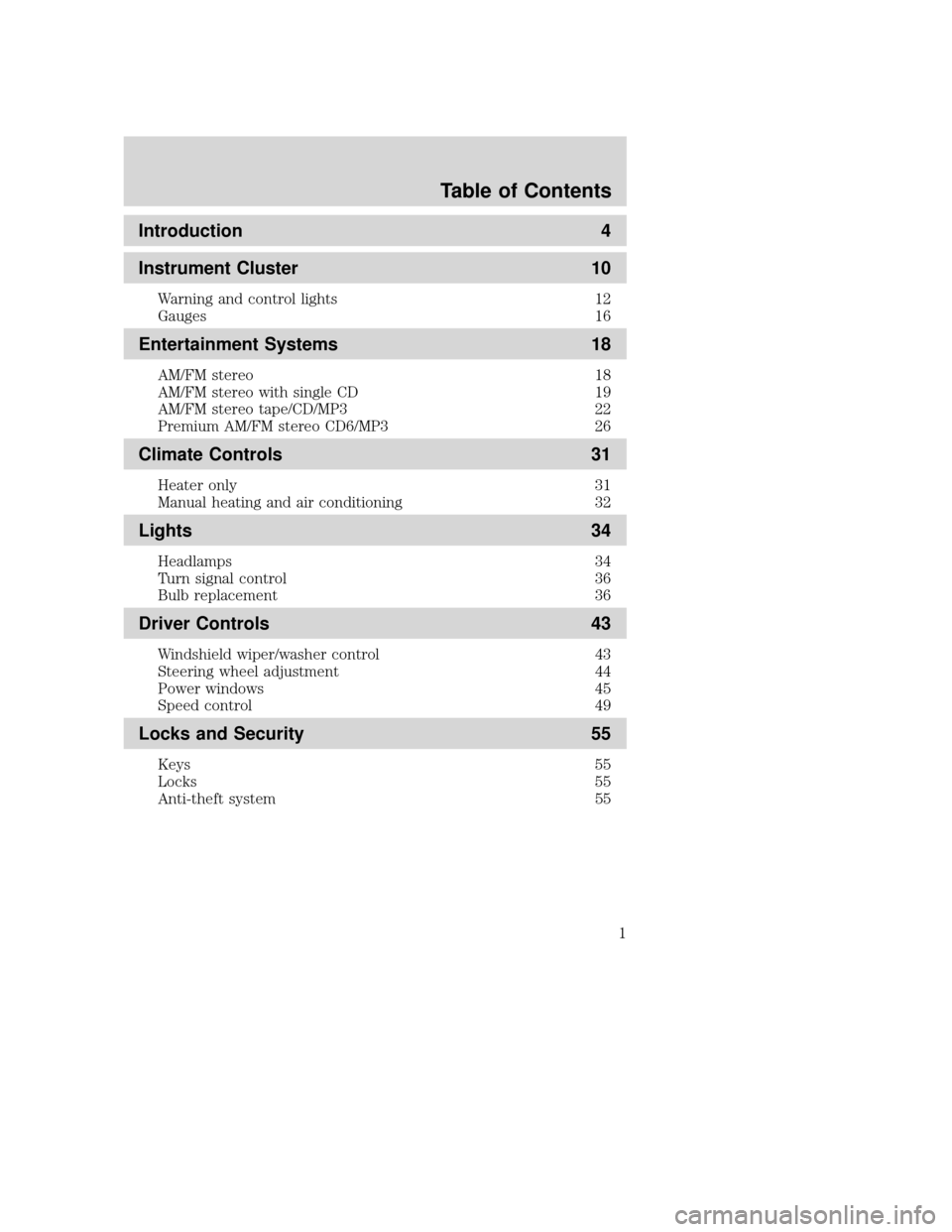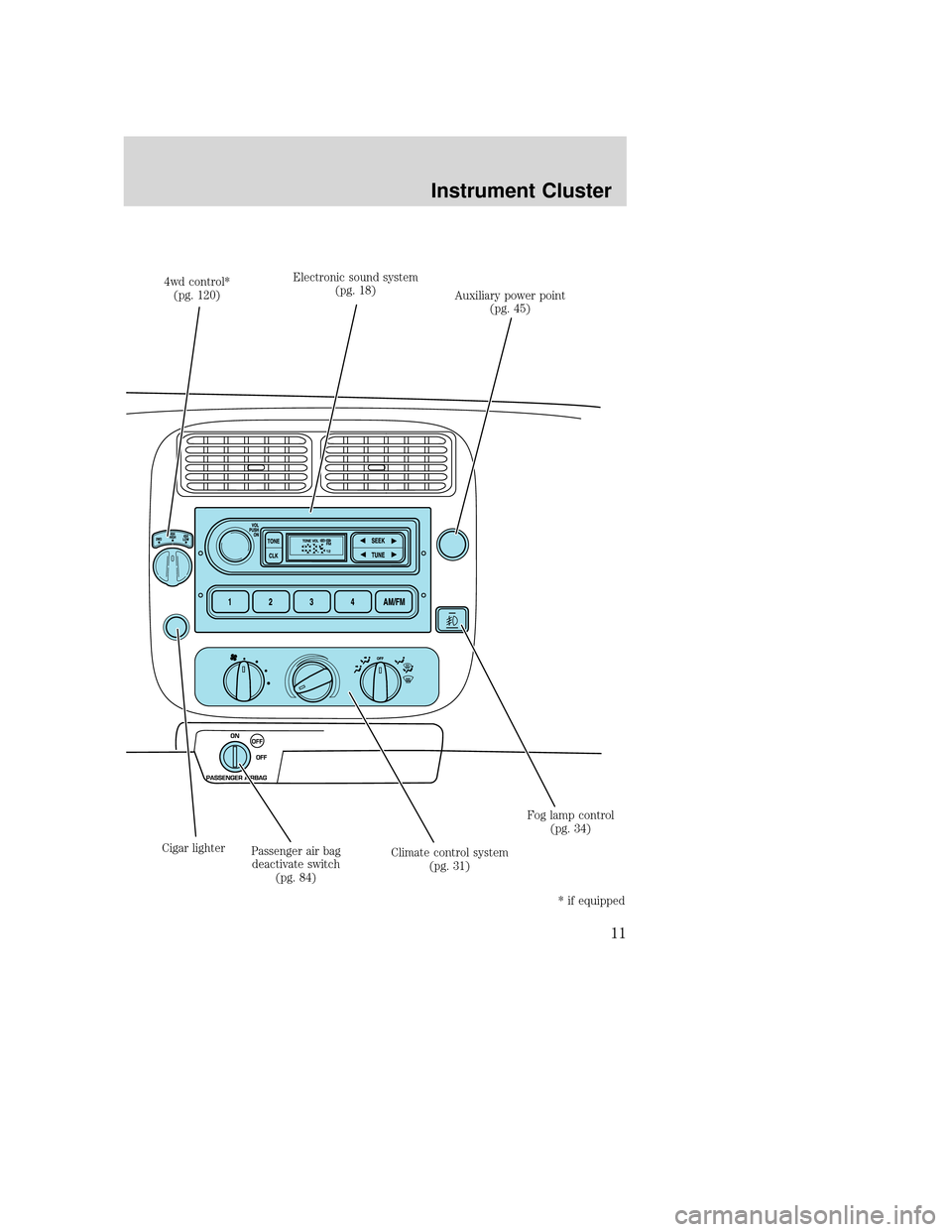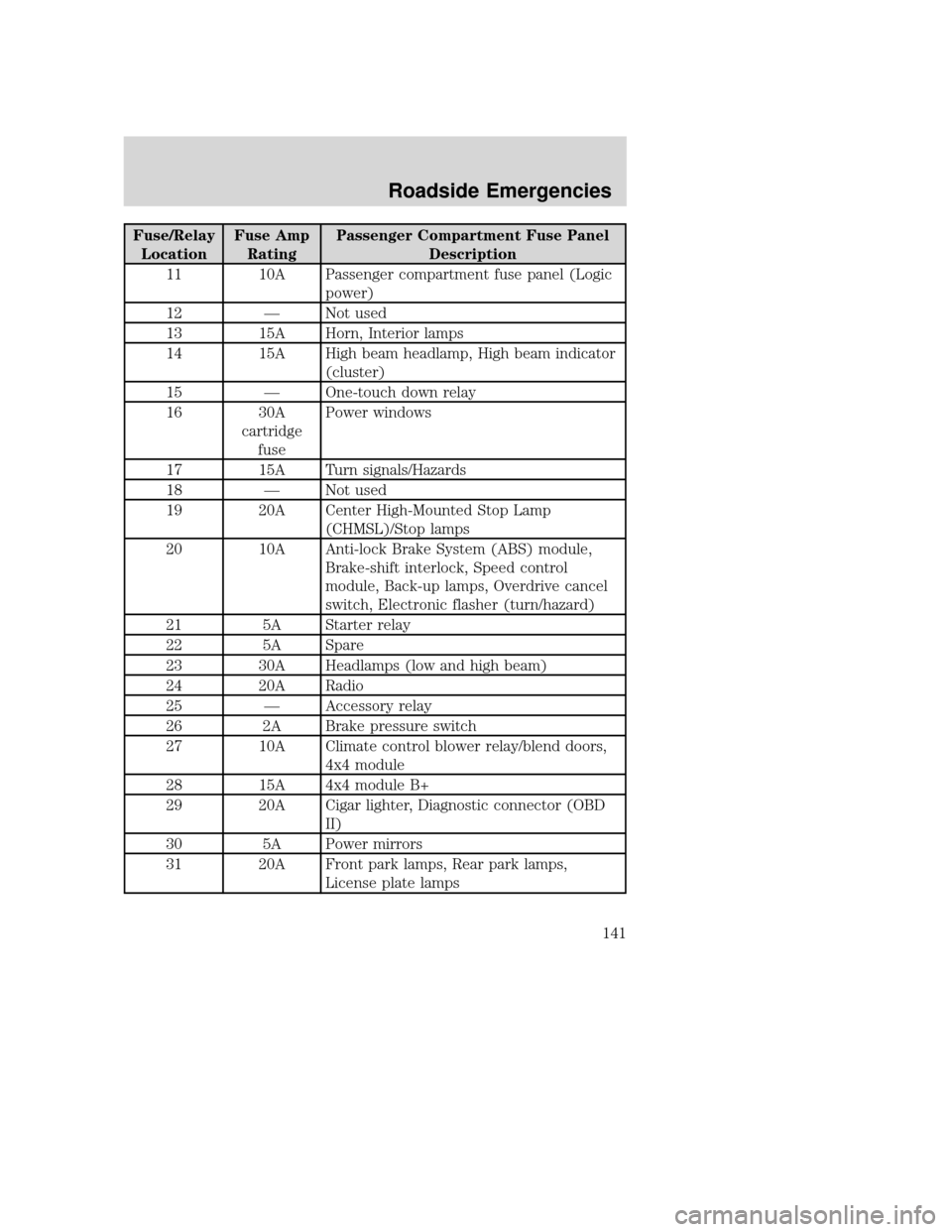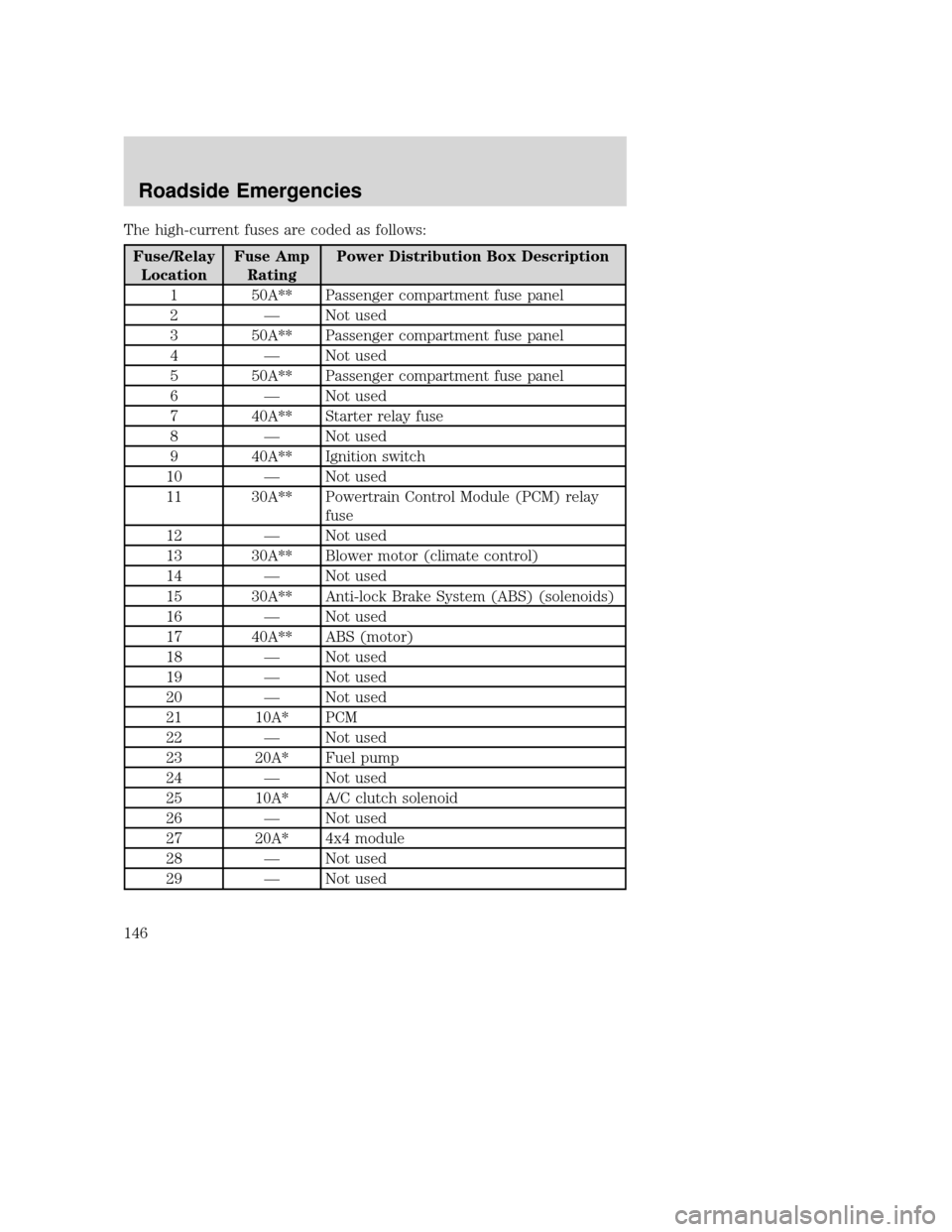climate control MAZDA MODEL B-SERIES 2004 Owners Manual (in English)
[x] Cancel search | Manufacturer: MAZDA, Model Year: 2004, Model line: MODEL B-SERIES, Model: MAZDA MODEL B-SERIES 2004Pages: 256, PDF Size: 1.97 MB
Page 1 of 256

Introduction4
Instrument Cluster 10
Warning and control lights 12
Gauges 16
Entertainment Systems18
AM/FM stereo 18
AM/FM stereo with single CD 19
AM/FM stereo tape/CD/MP3 22
Premium AM/FM stereo CD6/MP3 26
Climate Controls31
Heater only 31
Manual heating and air conditioning 32
Lights34
Headlamps 34
Turn signal control 36
Bulb replacement 36
Driver Controls43
Windshield wiper/washer control 43
Steering wheel adjustment 44
Power windows 45
Speed control 49
Locks and Security55
Keys 55
Locks 55
Anti-theft system 55
2004 Mazda B Series(mbs)
Owners Guide (post-2002-fmt)
Canadian French (fr-can)
Table of Contents
Table of Contents
1
Page 11 of 256

Climate control system(pg. 31)Auxiliary power point
(pg. 45)
Electronic sound system
(pg. 18)
Passenger air bag deactivate switch (pg. 84)
4wd control*
(pg. 120)
Fog lamp control(pg. 34)
Cigar lighter
* if equipped
2004 Mazda B Series(mbs)
Owners Guide (post-2002-fmt)
Canadian French (fr-can)
Instrument Cluster
11
Page 31 of 256

HEATER ONLY SYSTEM
(IF EQUIPPED)1. Fan speed adjustment:
Controls the volume of air
circulated in the vehicle.
2. Temperature selection:
Controls the temperature of the
airflow in the vehicle.
3. Air flow selections: Controls the direction of the airflow in the
vehicle. See the following for a brief description on each control.
: Distributes outside air through the instrument panel vents.
OFF: Outside air is shut out and the fan will not operate.
:Distributes outside air through the instrument panel vents and the
floor vents.
: Distributes outside air through the floor vents.
:Distributes outside air through the windshield defroster vents and
floor vents.
: Distributes outside air through the windshield defroster vents.
OPERATING TIPS
• To reduce fog build up on the windshield during humid weather, place
the air flow selector in the
position.
• To reduce humidity build up inside the vehicle during cold or warm
weather, do not drive with the air flow selector in the OFF position.
• Under normal weather conditions, do not leave the air flow selector in
OFF when the vehicle is parked. This allows the vehicle to “breathe”
using the outside air inlet vents.
• Do not put objects under the front seats that will interfere with the air
flow to the back seats.
• Remove any snow, ice or leaves from the air intake area at the base of
the windshield.
To aid in side window defogging/demisting in cold weather:
1. Select
2. Set the temperature control to full heat
3. Set the fan speed to HI
2004 Mazda B Series (mbs)
Owners Guide (post-2002-fmt)
Canadian French (fr-can)
Climate Controls
Climate Controls
31
Page 32 of 256

4. Direct the outer instrument panel vents towards the side windows
To increase airflow to the outer instrument panel vents, close the vents
located in the middle of the instrument panel.
WARNING: Do not place objects on top of the instrument panel
as these objects may become projectiles in a collision or sudden
stop.
MANUAL HEATING AND AIR CONDITIONING SYSTEM
(IF EQUIPPED) 1. Fan speed adjustment:
Controls the volume of air
circulated in the vehicle.
2. Temperature selection:
Controls the temperature of the
airflow in the vehicle.
3. Air flow selections: Controls the direction of the airflow in the
vehicle. See the following for a brief description on each control.
MAX A/C (if equipped): A/C compressor is ON. Recirculated air flows
from the instrument panel vents only. Temperature of air is not
adjustable (cold only).
A/C (if equipped): A/C compressor is ON. Outside air flows from the
instrument panel vents only.
: Distributes outside air through the instrument panel vents only.
(A/C compressor is OFF).
OFF: Outside air is shut off and the fan motor does not operate.
:Distributes outside air through the instrument panel vents and the
floor vents. (A/C compressor is ON).
: Distributes outside air through the floor vents. (A/C compressor is
OFF).
: Distributes outside air through the windshield defroster vents and
the floor vents. (A/C compressor is ON).
: Distributes outside air through the windshield defroster vents only.
(A/C compressor is ON).
OPERATING TIPS
• To reduce fog build up on the windshield during humid weather, place
the air flow selector in the
position.
2004 Mazda B Series (mbs)
Owners Guide (post-2002-fmt)
Canadian French (fr-can)
Climate Controls
32
Page 33 of 256

•To reduce humidity build up inside the vehicle: do not drive with the
air flow selector in the OFF position.
• Under normal weather conditions, do not leave the air flow selector in
MAX A/C or OFF when the vehicle is parked. This allows the vehicle
to “breathe” using the outside air inlet vents.
• Do not put objects under the front seats that will interfere with the
airflow to the back seats.
• Remove any snow, ice or leaves from the air intake area at the base of
the windshield.
To aid in side window defogging/demisting in cold weather:
1. Select
.
2. Modulate the temperature control to maintain comfort.
3. Set the fan speed to HI
4. Direct the outer instrument panel vents towards the side windows
To increase airflow to the outer instrument panel vents, close the vents
located in the middle of the instrument panel.
WARNING: Do not place objects on top of the instrument panel
as these objects may become projectiles in a collision or sudden
stop.
2004 Mazda B Series (mbs)
Owners Guide (post-2002-fmt)
Canadian French (fr-can)
Climate Controls
33
Page 141 of 256

Fuse/RelayLocation Fuse Amp
Rating Passenger Compartment Fuse Panel
Description
11 10A Passenger compartment fuse panel (Logic power)
12 —Not used
13 15A Horn, Interior lamps
14 15A High beam headlamp, High beam indicator (cluster)
15 —One-touch down relay
16 30A cartridgefuse Power windows
17 15A Turn signals/Hazards
18 —Not used
19 20A Center High-Mounted Stop Lamp (CHMSL)/Stop lamps
20 10A Anti-lock Brake System (ABS) module, Brake-shift interlock, Speed control
module, Back-up lamps, Overdrive cancel
switch, Electronic flasher (turn/hazard)
21 5A Starter relay
22 5A Spare
23 30A Headlamps (low and high beam)
24 20A Radio
25 —Accessory relay
26 2A Brake pressure switch
27 10A Climate control blower relay/blend doors, 4x4 module
28 15A 4x4 module B+
29 20A Cigar lighter, Diagnostic connector (OBD II)
30 5A Power mirrors
31 20A Front park lamps, Rear park lamps, License plate lamps
2004 Mazda B Series (mbs)
Owners Guide (post-2002-fmt)
Canadian French (fr-can)
Roadside Emergencies
141
Page 143 of 256

2.3L engine (if equipped)
The high-current fuses are coded as follows:
Fuse/RelayLocation Fuse Amp
Rating Power Distribution Box Description
1 50A** Passenger compartment fuse panel
2 —Not used
3 50A** Passenger compartment fuse panel
4 —Not used
5 50A** Passenger compartment fuse panel
6 —Not used
7 40A** Starter relay fuse
8 —Not used
9 40A** Ignition switch
10 —Not used
11 30A** Powertrain Control Module (PCM), Engine sensors
12 —Not used
13 30A** Blower motor (climate control)
1234521 22 23 24
25 26 27 28
29 30 31 32
33 34 35 36
37 38 39 40
41 42 43 44
678910 55
49
48 54
5352
51 56
56 B
56 A
50 50 B
50 A
47
45 45 B
45 A
4646 B
46 A
11 12 13 14 15
16 17 18 19 20
2004 Mazda B Series
(mbs)
Owners Guide (post-2002-fmt)
Canadian French (fr-can)
Roadside Emergencies
143
Page 146 of 256

The high-current fuses are coded as follows:
Fuse/RelayLocation Fuse Amp
Rating Power Distribution Box Description
1 50A** Passenger compartment fuse panel
2 —Not used
3 50A** Passenger compartment fuse panel
4 —Not used
5 50A** Passenger compartment fuse panel
6 —Not used
7 40A** Starter relay fuse
8 —Not used
9 40A** Ignition switch
10 —Not used
11 30A** Powertrain Control Module (PCM) relay fuse
12 —Not used
13 30A** Blower motor (climate control)
14 —Not used
15 30A** Anti-lock Brake System (ABS) (solenoids)
16 —Not used
17 40A** ABS (motor)
18 —Not used
19 —Not used
20 —Not used
21 10A* PCM
22 —Not used
23 20A* Fuel pump
24 —Not used
25 10A* A/C clutch solenoid
26 —Not used
27 20A* 4x4 module
28 —Not used
29 —Not used
2004 Mazda B Series (mbs)
Owners Guide (post-2002-fmt)
Canadian French (fr-can)
Roadside Emergencies
146
Page 227 of 256

diameters of 10 to 12 inches or limited production tires as defined in
Title 49 Code of Federal Regulations Part 575.104(c)(2).
U.S. Department of Transportation-Tire quality grades:The U.S.
Department of Transportation requires Mazda to give you the following
information about tire grades exactly as the government has written it.
Treadwear
The treadwear grade is a comparative rating based on the wear rate of
the tire when tested under controlled conditions on a specified
government test course. For example, a tire graded 150 would wear one
and one-half (1 1/2) times as well on the government course as a tire
graded 100. The relative performance of tires depends upon the actual
conditions of their use, however, and may depart significantly from the
norm due to variations in driving habits, service practices, and
differences in road characteristics and climate.
Traction AA A B C
The traction grades, from highest to lowest are AA, A, B, and C. The
grades represent the tire’ s ability to stop on wet pavement as measured
under controlled conditions on specified government test surfaces of
asphalt and concrete. A tire marked C may have poor traction
performance.
NOTE: The traction grade assigned to this tire is based on
straight-ahead braking traction tests, and does not include acceleration,
cornering, hydroplaning or peak traction characteristics.
Temperature A B C
The temperature grades are A (the highest), B, and C, representing the
tire’ s resistance to the generation of heat and its ability to dissipate heat
when tested under controlled conditions on a specified indoor laboratory
test wheel. Sustained high temperature can cause the material of the tire
to degenerate and reduce tire life, and excessive temperature can lead to
sudden tire failure. The grade C corresponds to a level of performance
which all passenger car tires must meet under the Federal Motor Vehicle
Safety Standard No. 109. Grades B and A represent higher levels of
performance on the laboratory test wheel than the minimum required by
law.
2004 Mazda B Series (mbs)
Owners Guide (post-2002-fmt)
Canadian French (fr-can)
Maintenance and Specifications
227
Page 239 of 256

closest safe area out of traffic. This may further damage the flat tire, but
your safety is more important.
If you feel a sudden vibration or ride disturbance while driving or you
suspect your tire or vehicle has been damaged, immediately reduce your
speed. Drive with caution until you can safely pull off the road. Stop and
inspect the tire for damage. If the tire is under-inflated or damaged,
deflate it, remove wheel and replace it with your spare tire and wheel. If
you cannot detect a cause, have the vehicle towed to the nearest repair
facility or tire dealer to have the vehicle inspected.
SNOW TIRES AND CHAINSWARNING: Driving too fast for conditions creates the
possibility of loss of vehicle control. Driving at very high speeds
for extended periods of time may result in damage to vehicle
components.
NOTE: Snow tires must be the same size and grade as the tires you
currently have on your vehicle.
The tires on your vehicle have all weather treads to provide traction in
rain and snow. However, in some climates, you may need to use snow
tires and chains. If you need to use snow tires and chains, it is
recommended that steel wheels are used of the same size and
specifications as those originally installed.
Follow these guidelines when using snow tires and chains:
• Do not use tire chains on aluminum wheels. Chains may chip the
wheels.
• Use only SAE Class S chains.
• Install chains securely, verifying that the chains do not touch any
wiring, brake lines or fuel lines.
Drive cautiously. If you hear the cables or chains rub or bang
against the vehicle, stop and retighten them. If this does not
work, remove the cables or chains to prevent vehicle damage.
• If possible, avoid fully loading your vehicle.
• Remove the tire chains when they are no longer needed. Do not use
tire chains on dry roads.
• The suspension insulation and bumpers will help prevent vehicle
damage. Do not remove these components from your vehicle when
using snow tires and chains.
2004 Mazda B Series (mbs)
Owners Guide (post-2002-fmt)
Canadian French (fr-can)
Maintenance and Specifications
239